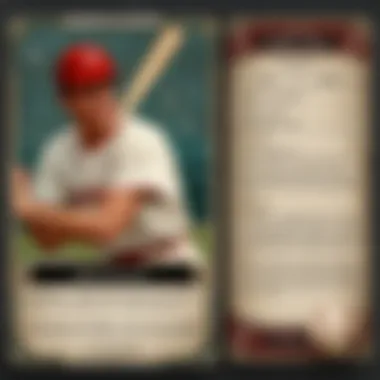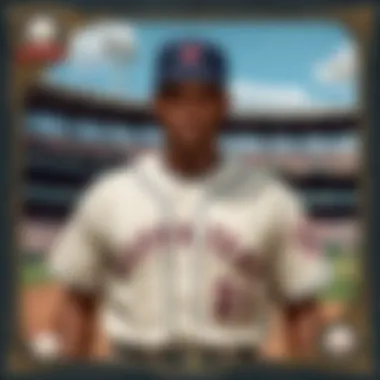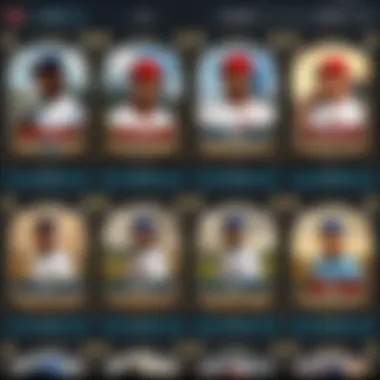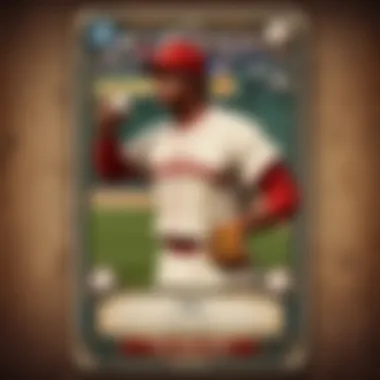Understanding the Value of Baseball Cards: A Deep Dive


Intro
Baseball cards have held a unique place in the hearts of collectors and investors over many decades. Their significance is not only tied to the nostalgia of watching games but also the intricate dynamics of valuation that govern their worth. Understanding these factors is essential for anyone interested in exploring the collectible market, whether passionate fan or financial strategist.
Valuation in the world of baseball cards hinges on various elements that contribute to the desirability and price tag of individual cards. As the market continues to evolve, collectors must adapt their strategies to maximize their investments. This article dissects the key components that define baseball card value, focusing on historical relevance, rarity, condition, and current market trends. Each section aims to offer readers a clear pathway to comprehend the complexities of this niche field.
Preamble to Baseball Card Collecting
Baseball card collecting is not merely a hobby; it is a complex realm that intertwines nostalgia, investment, and community. This introduction sets the stage for understanding both the emotional and economic significance of collecting baseball cards. It offers enthusiasts insight not only into the history but also into the strategies that define successful collecting.
The importance of this topic lies in the unique intersection it occupies between sports history and personal memory. Every card tells a story, often of the player’s achievements and the era in which they thrived. For many collectors, these cards evoke powerful emotions tied to personal moments or iconic games.
Brief History of Baseball Cards
Baseball cards have a rich history that dates back to the late 19th century. The first recorded baseball cards appeared in the 1860s, often as part of tobacco packaging. These early cards were not designed primarily for collectors, but they quickly gained popularity among fans. By the 1900s, manufactures like the American Tobacco Company began producing cards specifically for collecting.
As time progressed, the popularity surged with the advent of mass production in the 1950s. Iconic sets like Topps and Bowman turned the production of baseball cards into a significant industry. Cards showcased not just statistics but also artwork, reflecting the culture of their times.
Significance of Collecting
The significance of collecting baseball cards goes beyond monetary value. Collecting serves as a bridge connecting generations of fans and players. Shared experiences emerge from collecting and trading cards, fostering camaraderie among enthusiasts. For many, it becomes a form of expression, a way to display their love for the sport.
Investing in baseball cards can also yield substantial returns. Certain cards have appreciated in value significantly due to rarity and demand. However, the market is nuanced, requiring an understanding of various factors that influence card values. Collectors need to navigate this landscape carefully.
Collecting cards is a mix of joy and strategy. Knowledge of market trends, conditioning, and rarity are crucial to meaningful collecting.
In summary, the world of baseball card collecting is multifaceted. By exploring its history and significance, collectors gain a deeper appreciation for their hobby and can make informed decisions moving forward.
Factors Influencing Card Value
The valuation of baseball cards is not a straightforward process. There are multiple elements that affect how much a card is worth in a collector's market. Understanding these factors is crucial for anyone interested in collecting or investing in baseball cards. This section will discuss the primary influences on card value. These include rarity, condition, market demand, and historical significance. Each of these elements plays a significant role in determining the desirability and price of particular cards.
Rarity and Scarcity
Rarity is one of the most significant factors in determining card value. When a card is produced in limited quantities, it generally holds a higher status among collectors. Scarcity enhances exclusivity, which can drive prices upwards.
Collectibles such as the T206 Honus Wagner exemplify this principle. Originally, only a few were made, making it one of the rarest cards ever. If a card was part of a limited print run, it becomes substantially more valuable compared to cards that have many copies.
"The allure of rarity cannot be overstated; it is an essential aspect of card valuation."


In addition to high-profile one-offs, other factors also affect scarcity. For example, factory errors can make certain cards unique. While they are not as common, they still may attract a subset of collectors looking for something special.
Condition and Grading
The condition of a card is paramount. A card that is in pristine condition will always fetch a better price than one that is worn or damaged. Grading systems exist to classify cards according to their condition. The divide between a near mint and a good condition can result in significant price differences.
Professional grading organizations like PSA or Beckett assess cards based on various criteria. Factors such as centering, corners, edges, and surface all contribute to the overall grade. Higher graded cards tend to be more sought after, with prices reflecting their quality.
Market Demand
Market demand is another critical factor when evaluating baseball cards. The popularity of a player can boost demand significantly. For instance, cards depicting legendary figures such as Babe Ruth or modern icons like Mike Trout usually see a surge in interest during their prime years or when they achieve milestones. Market trends can quickly shift, causing values to fluctuate.
Keeping an eye on online platforms, such as eBay or specialized auction houses, can provide insight into current demand levels for specific cards. Economic factors can also play a role in this aspect. If the general economy is doing well, collectors may be willing to invest more in cards.
Historical Significance
The historical context surrounding a card is also a vital consideration. Cards that represent pivotal moments in baseball history tend to command higher values. For example, cards from seasons with rule changes or record-breaking performances may become collectively significant over time.
A player’s journey can add layers to a card’s story, making it more appealing to collectors. Cards associated with significant events, like championship games or Hall of Fame inductions, carry intrinsic value because they resonate with the identity of baseball itself.
In summary, each of these factors contributes uniquely to the overall valuation of baseball cards. Knowledge of rarity, condition, market demand, and historical context can empower collectors and investors as they navigate this fascinating arena.
The Most Valuable Baseball Cards
The significance of the most valuable baseball cards transcends mere monetary value. These cards represent milestones in sports history and the culture surrounding baseball. Their worth not only reflects rarity and condition but also the narrative behind the player and the moment captured in time. Consequently, collectors and investors often seek these high-value cards not just for profit but to own a piece of sports history. The following sections will explore some remarkable examples, illustrating why these cards hold immense value within the collectible market.
Overview of High-Value Cards
High-value baseball cards have garnered attention for their astronomical prices in auctions and private sales. These cards originate from various eras, each holding a unique place in the tapestry of baseball history. Factors like condition, rarity, and market demand contribute to their values, making them subjects of fascination and desire among collectors.
Some of the most notable cards have fetched millions, pushing the boundaries of what people perceive as collectible items. Understanding these cards gives insight into the larger landscape of card collecting, where passion meets investment.
T206 Honus Wagner
The T206 Honus Wagner card is often regarded as the holy grail of baseball cards. Produced between 1909 and 1911, this card features Wagner, a legendary player known for his excellence on the field. However, its rarity is what makes it so sought after. Only a limited number of these cards were produced, primarily due to Wagner's objections to their use in tobacco products. This protest resulted in his card being pulled from circulation.
The T206 Honus Wagner card sold for over $6 million in a recent auction, underscoring its status as one of the most valuable cards ever made. Its combination of historical significance, rarity, and condition solidifies its place in the hearts of collectors.
Topps Mickey Mantle
The 1952 Topps Mickey Mantle card is another cornerstone of baseball card collecting. Originating during the dawn of the modern card-collecting era, it features one of baseball's most iconic players, Mickey Mantle. This card gained additional value from its striking design and the timing of its release, coinciding with the peak of Mantle's career.


The value of this card soared, culminating in its last sales reaching over $5 million. This card is a symbol of the boom in baseball card collecting and reflects a deep connection fans share with the sport's legends.
Topps Mickey Mantle
Following closely in value is the 1961 Topps Mickey Mantle card. This card showcases him in a classic batting pose, capturing the essence of the player at that time. The 1961 version of the card is particularly notable for its design and has become a staple in many serious collections.
High-grade versions of the 1961 Topps Mickey Mantle card sell for substantial amounts, often reaching into the millions. Its value is linked to both its aesthetic appeal and Mantle's enduring legacy in baseball.
1909-1911 T206 Walter Johnson
The 1909-1911 T206 Walter Johnson card also holds a special place among valuable baseball cards. Walter Johnson was one of baseball's all-time great pitchers, and this card reflects his achievements during the early 20th century. Much like the T206 Wagner, its rarity is enhanced by the limited production runs.
Specific versions of the Walter Johnson card can fetch tens of thousands of dollars or more, depending on their condition. Its historical importance and the respect for Johnson as a player contribute to its high market value, making it a focal point for many collectors.
"Collecting baseball cards is not merely a hobby; it is a way of connecting with history and the legends who shaped the game."
In summary, understanding these high-value baseball cards is essential for anyone looking to grasp the full scope of the collecting world. These cards represent the pinnacle of what collectors aspire to own, acting as tangible connections to the sport's rich history.
Emerging Trends in Card Collecting
The landscape of baseball card collecting is continually evolving. This evolution is shaped by technological advancements, demographic shifts, and changing consumer preferences. Understanding these emerging trends is crucial for enthusiasts and investors alike. Staying informed allows collectors to adapt their strategies and potentially capitalize on new opportunities. The rise of digital collectibles and the increasing engagement of younger audiences are key factors currently influencing the hobby.
Digital Collectibles and NFTs
The introduction of digital collectibles has transformed the way people view and collect baseball cards. Non-fungible tokens (NFTs) have gained traction in recent years, offering collectors a new way to engage with their favorite players and teams. Digital cards hold unique advantages, such as being virtually indestructible and easily transferable. This attracts a tech-savvy generation that values accessibility and innovative experiences.
- Ownership and Authenticity: NFT technology ensures that every digital collectible is unique, verified, and owned by the collector. This eliminates concerns about forgeries, which have historically plagued traditional card collecting.
- Market Access: Digital platforms provide collectors access to a global marketplace, widening the pool of potential buyers and sellers.
- Engagement with the Community: Digital collectibles often come with interactive features. This includes online games and community events, fostering a sense of belonging among collectors.
However, the market for digital collectibles is still evolving. Collectors should tread carefully. The volatility is higher compared to traditional cards, and market trends can shift rapidly. It is essential to do research before investing.
Youth Engagement and New Collectors
Engagement from younger audiences is revitalizing the baseball card collecting hobby. Youth engagement is driven by several factors:
- Social Media Influence: Platforms like Instagram and TikTok allow young collectors to showcase their collections. This visibility encourages others to join in. Viral trends enhance interest in both collecting and trading cards.
- Affordable Options: Manufacturers are increasingly offering lower-priced packs. This accessibility invites younger collectors, allowing them to start without a hefty investment.
- Educational Initiatives: Many local card shops and online forums dedicate resources to educate newcomers about collecting. They provide insights on grading, market value, and card care, creating more informed collectors.
The influx of new collectors can influence market dynamics. With fresh perspectives and innovative ideas, youth engagement is essential for the longevity of the hobby. Collectors benefit from understanding their tastes and preferences, leading to fruitful trading and investment opportunities.
"The continual adaptation to emerging trends in card collecting sets the stage for a vibrant future, underlining the importance of embracing change while holding onto tradition."


As the collecting landscape continues to change, staying informed and flexible is vital. Collectors who recognize and adapt to these trends can enhance their collections and investment strategies.
Collecting Strategies
Collecting baseball cards is not just a hobby; it is an art and a personal investment. The strategies employed in building a collection can drastically affect both the enjoyment derived from the hobby and the potential return on investment. Understanding how to navigate the intricate market is essential for collectors, whether they are seasoned veterans or fresh newcomers. This section elaborates on building a collection, identifying hidden gems, and useful selling and trading tips that can elevate a collector's approach.
Building a Collection
Building a baseball card collection requires thoughtful planning and an understanding of personal goals. A systematic approach can involve several factors:
- Focus: Are you aiming for certain players, teams, or eras? Defining a clear scope helps to streamline your efforts.
- Budget: Establishing a financial limit allows you to make recorded and responsible decisions. This helps you avoid impulse purchases.
- Research: Knowledge is power. Familiarize yourself with current market trends and card values. Websites like Wikipedia and Britannica provide useful historical context and market insights.
Understanding the rarity and condition of potential cards is crucial as well. Seek reputable dealers or auctions to avoid pitfalls. Participating in community discussions on platforms like Reddit can enrich your knowledge base and connect you with fellow enthusiasts who have shared experiences.
Identifying Hidden Gems
The search for hidden gems in the baseball card realm involves a combination of intuition and research. Cards that may not be mainstream yet can often appreciate significantly. Consider the following:
- Underappreciated Players: Emerging talents or vintage players who haven’t received the spotlight could yield significant returns if their careers take off.
- Misprints and Variations: Some cards may have printing errors or unique variations that make them more desirable than standard issues.
- Local Teams: Sometimes, cards from local teams or lesser-known players can attract niche collectors.
Pay attention to social media discussions and collector forums. Track auctions to identify cards that go unrecognized yet could have worth. Your focus should lie not just in quantity but in smart acquisitions.
Selling and Trading Tips
Successfully selling or trading baseball cards can lead to valuable exchanges and expansion of your collection. Here are some tactical considerations:
- Timing the Market: Just like any investment, timing can be pivotal. Pay attention to seasons, player performances, and market fluctuations. Selling a card when a player's stock is high often leads to better returns.
- Presentation: If selling online, present your cards well with high-quality images and detailed descriptions. Honesty about condition and grading is essential.
- Negotiating Skills: Cultivate strong negotiation abilities whether online or in-person. Understanding market values will help you secure better deals.
"Collecting cards is more than just economics; it's about passion and the stories behind each card."
Finale and Future Outlook
Understanding how to assess card value allows individuals to appreciate their investments better. It cultivates a deeper connection to the hobby by revealing the stories behind cards. Additionally, the trends we discussed can serve as a compass for future investments, guiding enthusiasts in their pursuits.
Looking ahead, the baseball card market remains dynamic. Changes in consumer preferences, advancements in digital technology, and the emergence of collectible platforms are shaping the future of collecting.
Final Thoughts on Value
In reflecting on the value of baseball cards, it is essential to acknowledge their duality as both a nostalgic hobby and a viable form of investment. Cards can evoke memories of cherished moments, while at the same time, representing a tangible asset. High-value cards not only tell stories of baseball history but also highlight significant cultural milestones.
Collectors must remember that value is not solely measured in monetary terms. The relationships forged through collecting can be just as significant. It connects individuals across demographics, fostering community and shared experiences. Evaluating value requires considering each card’s legacy and how it fits within the larger narrative of baseball.
Predictions for the Market
Predicting the future of the baseball card market involves analyzing current trends and considering potential shifts in collectors' preferences. Over the next few years, it is likely we will see an increase in both traditional and digital card collecting. The rise of NFTs has already begun to influence how collectors view ownership and authenticity. As more enthusiasts engage with digital platforms, the market for physical cards may also adapt, integrating technology without losing its charm.
Furthermore, younger generations are entering the hobby, bringing new energy and perspectives. Their interests will help shape the future dynamics, introducing fresh demand for previously overlooked cards.















